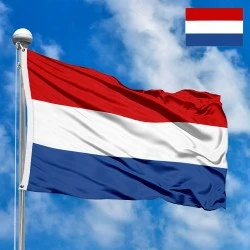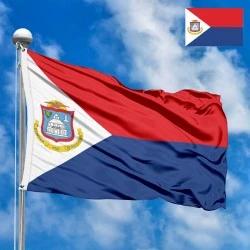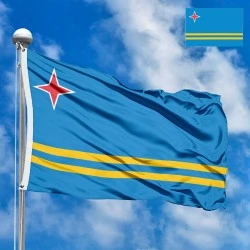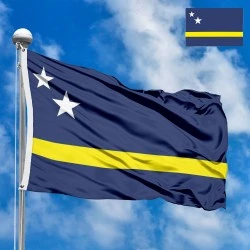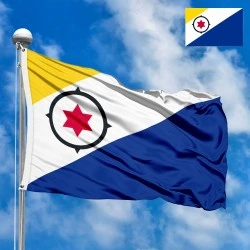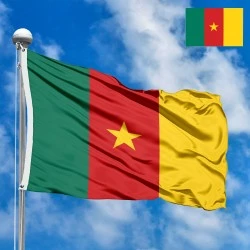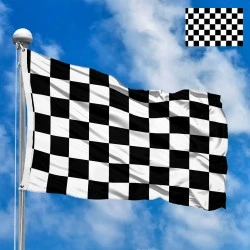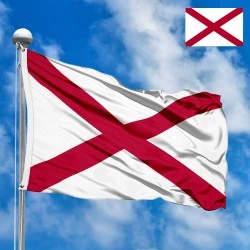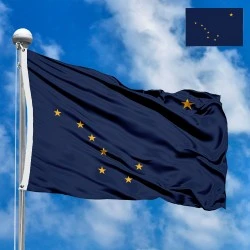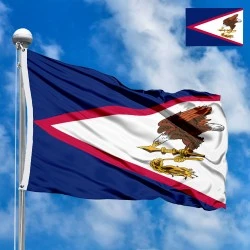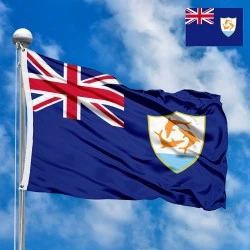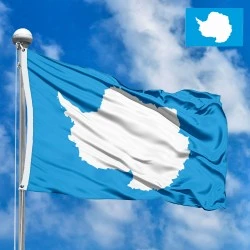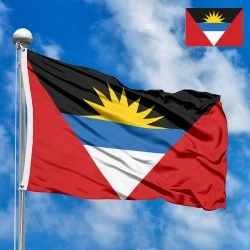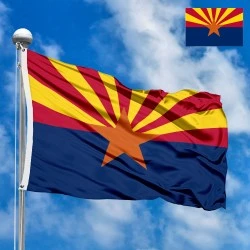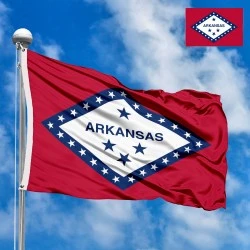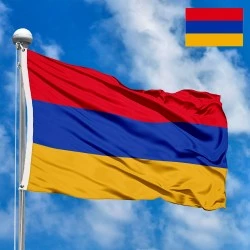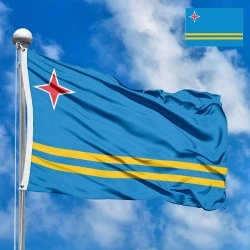Flag of the Netherlands Antilles
- Flag Type: Regional
- Proportions (official): 2:3
- Official name: Nederlandse Antillen
- Local name: Nederlandse Antillen
- Sovereignty (year): NO (Constituent country of the Kingdom of the Netherlands, dissolved in 2010)
- Country code, territory: AN, ANT, 530 (withdrawn)
- Capital: Willemstad
- Large cities: Willemstad, Kralendijk, Philipsburg
- Population: ~225,000 (2010, estimate)
- Religions: Christianity
- Area (km²): 800
- Highest point: Mount Scenery (887 m)
- Lowest point: Caribbean Sea (0 m)
- Currency: Netherlands Antillean guilder (ANG, ƒ)
- Languages: Dutch, Papiamento, English
- Dialing code: +599
- National domain: .an (deprecated)
Flag Information
General information
Demography and Culture
Economy and communications
- All Flags
- Flags of Countries by Continent
-
Flags of Organizations
- Flags of UN countries
- Flags of the European Union countries
- Flags of NATO countries
- Flags of the countries of the Organization of Islamic Cooperation
- Flags of the countries of the Organization of American States
- Flags of the Arab League countries
- Flags of the African Union countries
- Flags of the countries of the Union of South American Nations
- Flags of the Commonwealth of Nations
- Flags of the countries of the Secretariat of the Pacific Community
- Flags of the Nordic Council countries
- Flags of the Caribbean Community
- Flags of the countries of the Association of Southeast Asian Nations
- Flags of the East African Community
- Flags of the countries of the Organization of Turkic States
- LGBT Community Flags
- Historical Flags
- Ethnic Flags
- Flags of the USA (states)
Description
The flag of the Netherlands Antilles is a powerful historical symbol that represents a now-dissolved country, a testament to a period of unity and cooperation between several Caribbean islands. The flag was officially adopted on November 19, 1959, and remained in use until the country's dissolution on October 10, 2010. Its design perfectly encapsulated the political structure and the collective identity of the six islands that made up this self-governing entity within the Kingdom of the Netherlands. The flag’s legacy lives on in the distinct flags of its successor territories, but its own unique design remains a vital part of the region's history. It is a banner that tells a story of unity, diversity, and the eventual evolution of sovereignty in the Caribbean.
Design and Symbolism: A Banner of Unity
The flag of the Netherlands Antilles was a striking and minimalist design, featuring a white field with a vertical red stripe and a horizontal blue stripe, forming a cross. In the center of this cross, there was an oval pattern of five five-pointed white stars. After the secession of Aruba in 1986, the number of stars was reduced to five, as the federation was then composed of only five islands.
-
The Colors (Red, White, Blue): The dominant colors of the flag—red, white, and blue—are a direct reference to the flag of the Netherlands, symbolizing the constitutional ties and historical connection to the Kingdom of the Netherlands. This color scheme proudly represented their status as a constituent country of the Kingdom.
-
The White Field: The large white field symbolized peace and purity. It also served as a backdrop to highlight the flag's central elements, creating a clean, modern, and memorable design.
-
The Stripes: The red and blue stripes, crossing each other to form a cross, were a unifying element. They visually connected the five islands, holding them together in a single, cohesive design. The cross shape itself can be interpreted as a symbol of faith and of the geographical crossroads of the islands.
-
The Stars: The stars were the most critical and symbolic element of the flag. Each star represented one of the six islands that originally made up the Netherlands Antilles:
-
Aruba
-
Bonaire
-
Curaçao
-
Saba
-
Sint Eustatius
-
Sint Maarten
The stars were arranged in an oval pattern, symbolizing the collective unity and equality of the islands. The use of white stars on the red and blue stripes further reinforced their connection to the Dutch colors. After Aruba's secession in 1986, the flag was updated with only five stars, one for each remaining island, maintaining the same symbolism and design.
-
History and Creation: From Federation to Dissolution
The history of the Netherlands Antilles flag is inextricably linked to the political evolution of the Caribbean territories within the Dutch kingdom.
-
Federation and Formation: After World War II, the political structure of the Dutch Caribbean territories began to change. In 1954, the Netherlands Antilles were established as a constituent country within the Kingdom of the Netherlands, giving the islands a greater degree of self-government. The need for a unified national symbol to represent this new country became apparent. A competition was held to design a flag. The winning design was created by Jacoba (Joceline) E. M. Buncamper-Molloy, from Sint Maarten. Her design was officially adopted in 1959.
-
Aruba's Secession: A major change came in 1986 when Aruba was granted "status aparte" (separate status) and became its own constituent country within the Kingdom of the Netherlands. This event was a significant step toward the eventual dissolution of the Netherlands Antilles. The flag was subsequently redesigned to remove one of the six stars, leaving only five to represent the remaining islands.
-
Dissolution of the Country: The Netherlands Antilles officially ceased to exist on October 10, 2010. Following its dissolution, the islands of Curaçao and Sint Maarten became new constituent countries within the Kingdom of the Netherlands, each adopting their own distinct flags. The remaining islands—Bonaire, Saba, and Sint Eustatius—became special municipalities of the Netherlands, now known collectively as the Caribbean Netherlands. The flag of the Netherlands Antilles was retired from official use, but its image remains an important part of the region’s historical memory.
Size and Proportions
The flag of the Netherlands Antilles had a standard width-to-length ratio of 2:3. This proportion was consistent with international vexillological standards, ensuring the flag was always displayed correctly. The official colors were defined to match the Dutch tricolor, ensuring a visual link to the mother country.
Interesting Facts and Legacy
The flag of the Netherlands Antilles holds a unique place in history as a symbol of a country that no longer exists.
-
The Six Stars of Unity: The original six stars were a powerful symbol of unity for the islands, despite their geographic and cultural differences. The flag was a constant reminder that they were a single country, united under the same banner.
-
A Symbol of Change: The reduction of the stars from six to five in 1986 was a very visible and symbolic representation of the political changes happening within the Kingdom. It was a clear sign that the federation was in a state of transition.
-
Legacy in New Flags: The flags of the successor countries and municipalities often incorporate elements of the old flag. For example, the flags of Bonaire, Curaçao, Sint Maarten, and Saba all feature stars, and the Dutch colors are a common theme, demonstrating a clear legacy from the Netherlands Antilles flag.
Significance for the People
For the generations who lived under its banner, the flag of the Netherlands Antilles was a source of collective pride and identity. It represented a time of shared governance, cultural exchange, and a common destiny. While the islands have since gone their separate ways, the flag remains a poignant symbol of their shared past. It is a historical emblem that signifies their journey from colonial rule to self-governance and, ultimately, to new political structures. The flag is remembered as a banner of unity, representing a unique chapter in the history of the Caribbean and the Dutch Kingdom, a time when six islands were bound together under a single constellation of stars.
In the demonstration images, full-size flags are shown with proportions of 2:3, and hand-held flags with proportions of 1:2.
Donation
Download
Completely free for commercial and non-commercial use (public domain).
You can freely use them in your news magazines, websites, software, mobile applications.
We appreciate a backlink to https://flagssite.com
Raster files - Flag of the Netherlands Antilles (PNG, JPG)
 Waving flag
Waving flag
- PNG format (transparent background), 72dpi, dimensions in Pixels (px), aspect ratio 3:4.
- 15х20 px
- 30х40 px
- 60х80 px
- 120x160 px
- 240x320 px
 Sizes:
Sizes:
"v15" - image size (by height); if necessary, replace with available: v15, v30, v60, v120, v240.
!!! For resizing, use the Latin (eng) keyboard layout.
<img src="https://flagssite.com/flags/v15/20538.png" alt="Flag of the Netherlands Antilles">
 Round flag
Round flag
- PNG format (transparent background), 72dpi, dimensions in Pixels (px), aspect ratio 1:1.
"d15" - image size (diameter); if necessary, replace with available: d15, d30, d60, d120, d240.
!!! For resizing, use the Latin (eng) keyboard layout.
<img src="https://flagssite.com/flags/d15/20538.png" alt="Flag of the Netherlands Antilles">
 Rectangular flag 2:3
Rectangular flag 2:3
- JPG format, 72dpi, dimensions in Pixels (px), aspect ratio 2:3.
"h30" - image size (by height); if necessary, replace with available: h15, h30, h60, h120, h240, h360, h480.
!!! For resizing, use the Latin (eng) keyboard layout.
<img src="https://flagssite.com/flags/h30/20538.jpg" alt="Flag of the Netherlands Antilles">


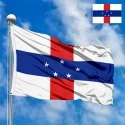
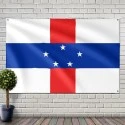
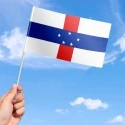

 Sizes:
Sizes:
 Sizes:
Sizes:
